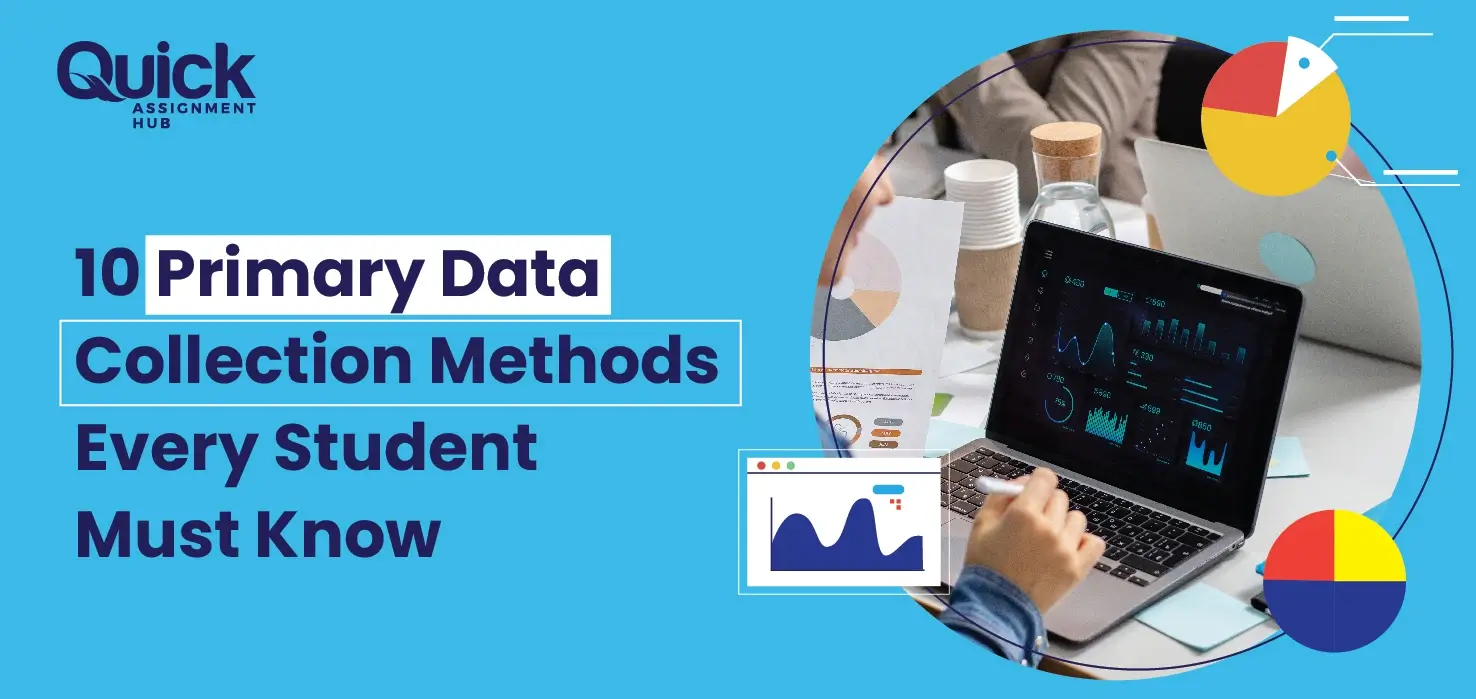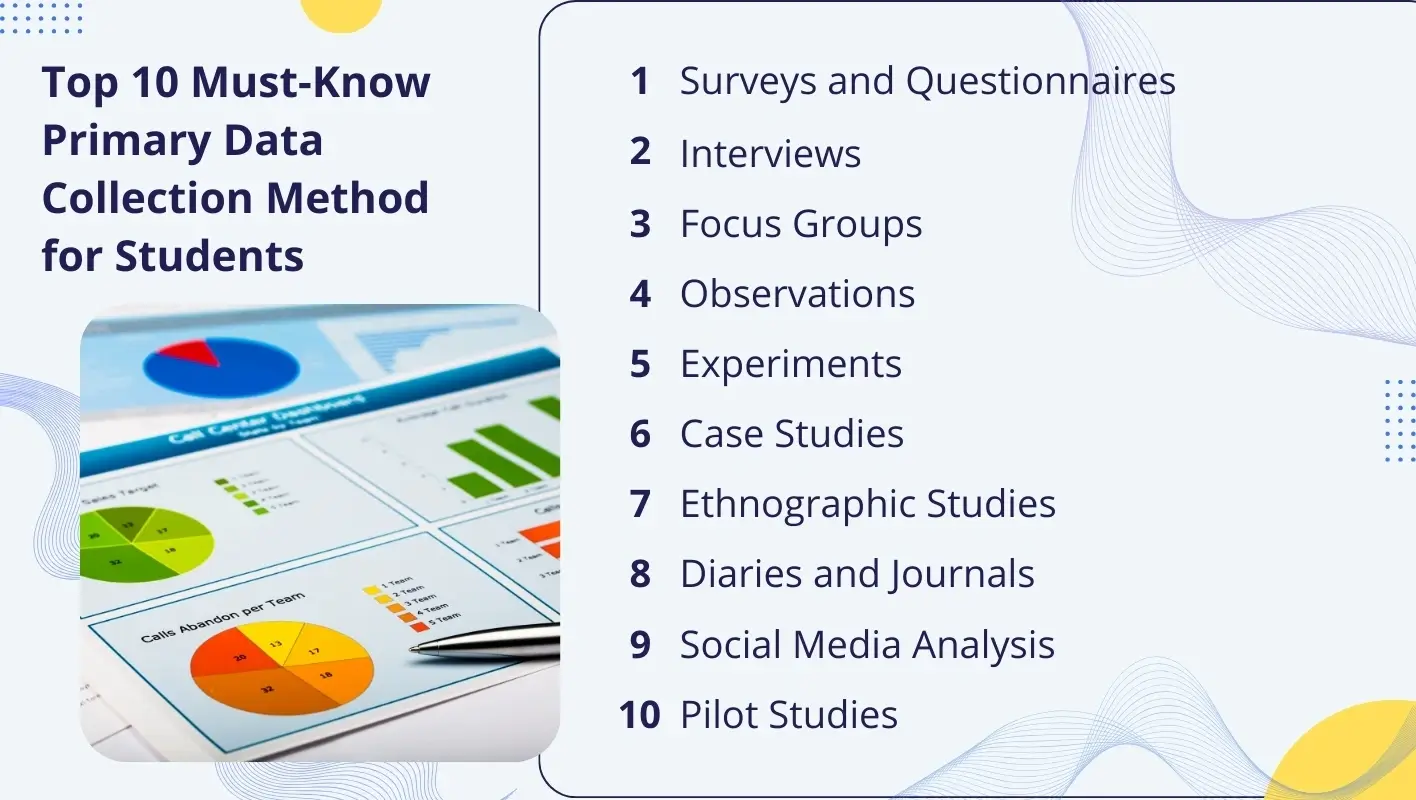
Primary Data collection in recent days is catching high importance due to information collected firsthand directly from sources, tailored to meet specific research objectives.
Unlike secondary data, it is original, accurate, and highly relevant, as it's gathered through surveys, interviews, experiments, or observations. This type of data is vital for businesses, researchers, and decision-makers seeking fresh, actionable insights.
Primary Data Collection Methods are essential for obtaining reliable, first-hand information directly from the source. These methods, including surveys, interviews, focus groups, and observations, allow researchers to tailor data collection to their specific objectives, ensuring relevance and accuracy. By using the Primary Data Collection Method, researchers can address unique research questions, fill gaps in existing studies, and obtain real-time insights that secondary data cannot provide. This approach minimizes biases, enhances data authenticity, and supports
evidence-based decision-making. Whether for academic, business, or scientific purposes, collecting primary data is critical to building solid foundations for analysis, innovation, and strategic planning.
Also read: Top 20 Sustainable Research Topic Ideas To Work On
Given below are some of the key differences between Primary and Secondary data collection:
| Aspect | Primary Data Collection | Secondary Data Collection |
|---|---|---|
| Definition | It contains original raw data collected firsthand through research methods. | Contains data derived from previously collected and processed sources. |
| Source | Obtained directly through methods like surveys, interviews, or experiments. | Extracted from existing resources like journals, reports, or statistical records. |
| Specificity | Tailored to specific research needs and objectives. | Generalized data that may not fully align with current research needs. |
| Reliability | Highly reliable as the researcher controls the data collection process. | It may contain biases or inaccuracies depending on the quality of the source. |
There are various methods for primary data collection; below are the 10 most powerful methods that can help you in the process.

Explanation: Surveys involve structured questions distributed to a target group to gather specific information.
Example: A student distributing Google Forms to peers to study smartphone usage habits.
Challenges: Low response rates and poorly framed questions lead to biased or inaccurate data.
Explanation: A direct conversation between the researcher and the participant to obtain detailed insights.
Example: A psychology student interviewing patients to understand stress triggers.
Challenges: Time-intensive, interviewer bias, and difficulties in scheduling participants.
Explanation: A guided discussion among a small group to explore opinions or attitudes.
Example: Marketing students discussing customer preferences for a new product prototype.
Challenges: Managing dominant participants, ensuring equal contribution, and interpreting subjective data.
Explanation: Observing behaviours in a natural or controlled environment without direct interaction.
Example: Education students observing classroom interactions to study teaching methods.
Challenges: Observer bias, ethical concerns, and inability to control external factors.
Explanation: Controlled studies to test hypotheses by manipulating variables and observing outcomes.
Example: A biology student experimenting with fertilizers' effects on plant growth.
Challenges: High costs, time constraints, and maintaining control over variables.
Explanation: In-depth analysis of a single subject, group, or situation to explore complex issues.
Example: Business students studying the growth trajectory of a startup.
Challenges: Time-consuming and potential lack of generalizability.
Explanation: Immersive research involves living or interacting with a community to understand its culture.
Example: Anthropology students studying rituals in indigenous tribes.
Challenges: Long-term commitment, cultural barriers, and ethical considerations.
Explanation: Asking participants to document their thoughts, activities, or behaviours over time.
Example: Healthcare students asking patients to maintain a food diary for dietary research.
Challenges: Non-compliance, incomplete entries, and inaccuracies in self-reporting.
Explanation: Using social media platforms to collect primary data on trends, preferences, and behaviours.
Example: Marketing students analyzing Instagram hashtags to gauge fashion trends.
Challenges: Privacy concerns, data reliability, and access limitations.
Explanation: Conducting a small-scale preliminary study to refine the primary data collection method and objectives.
Example: Engineering students testing user reactions to a prototype app before its full launch.
Challenges: These may not always represent larger populations, and findings are often inconclusive.
Ethical Concerns: Ensuring participant consent and data privacy.
Resource Constraints: High costs, time, and logistical challenges.
Bias and Reliability: Risk of researcher or participant bias affecting data quality.
Scalability: Difficulty in applying findings to larger populations.
Your First Order
Get 20% OFF!
The table below states details about quantitative and qualitative research:
| Aspect | Quantitative Research | Qualitative Research |
|---|---|---|
| Nature of Data | Numerical data focused on measurements and statistics. | Non-numerical data focused on understanding concepts, opinions, or experiences. |
| Objective | To quantify variables and test hypotheses using statistical methods. | To explore and interpret meanings, behaviors, or social phenomena. |
| Primary Data Collection Method | Surveys, experiments, structured observations. | Interviews, focus groups, open-ended surveys, ethnography. |
| Outcome | Produces objective, generalizable results. | Provides in-depth, context-specific insights. |
Below is a list of significant points that highlight the importance and usefulness of primary data collection in research work.
Primary data collection methods provide firsthand, accurate, and directly sourced information, ensuring that the data is highly relevant and tailored to the research needs. This direct approach eliminates the risks of data misinterpretation found in secondary data.
Unlike secondary data, primary data is designed to meet the specific needs of a study. Researchers can address unique questions and objectives with precise data collection methods, ensuring the research stays focused and aligned with its goals.
Primary data is beneficial for discovering new trends, understanding behaviours, or testing hypotheses in real-time scenarios. Methods like surveys, interviews, and observations help gather data that reflects current conditions, behaviours, and responses, making it invaluable for cutting-edge research.
Data collection methods such as interviews and experiments allow researchers to gather detailed, context-specific insights that secondary data might not provide. Interviews, for example, reveal nuanced perspectives, while experiments establish transparent cause-and-effect relationships through controlled environments.
Primary data collection allows researchers to customize their instruments
(e.g., surveys and interview guides) to align with specific research objectives. This enhances the reliability of the data, as it is directly suited to the study's goals.
Since primary data is collected in real-time, it ensures that the data is current and relevant. This reduces the risks associated with using outdated or irrelevant information and ensures more informed decision-making and analysis.
Primary data collection is one of the critical factors in research. Below are some smart tips for primary data collection. Following these tips will support you in organizing your data collection.
Select methods that align with your research objectives and target audience. Surveys are ideal for large populations, interviews provide in-depth insights, and observations capture real-time behaviours. For instance, using questionnaires for customer feedback ensures structured data collection tailored to your study.
Identify the group from whom you need data. A clear understanding of demographics, such as age, location, or profession, ensures the relevance of the information collected. For example, a study on student habits should target specific age groups using suitable data collection methods.
Prepare tools like surveys, interview guides, or observation checklists with clear, unbiased, and focused questions. Piloting these tools ensures they are practical and aligned with your research needs, improving the reliability of the results.
Ensure participants' consent, maintain confidentiality, and respect cultural sensitivities during the process. Ethical adherence builds trust and ensures higher participation and quality of responses, which is vital across all data collection methods.
Data collection for quantitative research needs a specific set of skills and methods, so following the essential tips below will help you ease your task.
A widely used data collection method, surveys involve distributing structured, close-ended questions to a large sample. This technique provides measurable and standardized data that is ideal for statistical analysis. For example, online forms can be used to gather customer satisfaction scores.
A controlled primary data collection method where variables are manipulated to study cause-and-effect relationships. This technique is essential in fields like natural sciences and psychology. For instance, testing the impact of different teaching methods on student performance.
Observing specific behaviours or events in a systematic manner using predefined criteria. This quantitative data collection method ensures consistency and replicability in results. For example, recording the frequency of customer visits to a store.
Using pre-existing numerical data such as census reports, financial statistics, or organizational records. Though secondary, this primary data collection method supports quantitative research by providing a foundation for hypothesis testing.
Data collection assignments can be challenging and time-consuming, requiring precision, in-depth research, and a thorough understanding of methodologies. Students often face difficulties in selecting the proper techniques, analyzing data effectively, and adhering to tight deadlines. Professional assistance can simplify this process and ensure high-quality results.
Quick Assignment Hub is an excellent platform for professional assignment help, offering assignment expert guidance tailored to your specific needs. Their support not only saves time but also ensures that assignments meet academic standards and research objectives. Relying on trusted professionals like Quick Assignment Hub can make data collection assignments manageable and stress-free.